Additional Charts for June and September

Here you are, facing those vast, dark expanses of sky! What to see. How to proceed? Just follow the main tutorial below, 'Touring the Summer Night Skies, a Guide', while using the appropriate charts. You will note that we assume that you know where the South, North, West and East are, relative to your observation location (that's easily found with a compass, or with a chart). The charts, further, are given for 10:30 p.m. local time -which is the usual time for which the night sky charts, usually, are given. The color charts are added with printer-friendly charts as it's mostly those latter ones that you'll like to take with you on the field
Some additional tools are provided below still, with sky charts pertaining to June and September, allowing for people who would enjoy their holidays during those month, to extrapolate what is said from the summer sky either side of July and August. The texts with the charts however, are those which are published on the site 'Amateur Astronomy' along the year, and don't provide thus for such a detailed guide to the skies than the specially dedicated tutorial to the sky in July and August. Hence the user will have to made those extrapolations by himself! Some hints however are giving at the section where the June and September charts are displayed
At last, in any case, read the three following remarks, which are mandatory for a better use of our tutorials:
- note #1: we assume that you know where the South, North, West and East are, relative to your observation location (that's easily found with a compass, or with a chart). The charts, further, are given for 10:30 p.m. local time -which is the usual time for which the night sky charts, usually, are given. The detailed color charts are added with printer-friendly charts as it's mostly those latter ones that you'll like to take with you on the field
-note #2: you will note that, as far as our site's charts are concerned, they do not bear, by a worry of legibility, any name of the bright stars. As our description refer to such names, just consider that those mostly are, on the chart, the brightest star of a constellation in question
- note #3: you'll note that you may have to apply some correction to any chart, function of the DST or ST you have at your location. Our site is applying a uniform 1-hour DST time shift, from April to October in the northern hemisphere, with the charts reflecting that choice
- note #4: a current tendency of the astronomical softwares and charts is to shift from the constellations' shapes as they are usually defined and recognized by the amateur astronomy community. The following color charts on this page are those which are shifting the most in this regard, as the printer-friendly charts are those who do less and are the ones to be used to memorize the basic shapes of the constellations, albeit still not completely accurate. read more!
| Touring the Summer Night Skies, a Guide Additional Charts for June and September |
Hemispherical Sky Charts |
During summer, the show, in the sky, mostly is South! Turn South!
Two fields, essentially, are of interest, South. The summer sky, first, is displaying one of those distinctive features, allowing to tell to what seasonal sky we're looking at. For the summer nights, it's the 'Summer Triangle'. During winter, you would have to look for the 'Great Winter Sky', with Orion, for example. The Summer Triangle, like the name, is a vast triangle formed by three bright stars. It's currently hanging high, slightly southeast! Thus, raise your head and look into that direction! You should easily spot a vast triangle of stars, with one near the zenith (the point of the sky directly above you), another one to the bottom of it, slightly left (at a distance of largely more than a handspan, all fingers stretched), and a third star barely higher than the first one, to its left, and at about a handspan from it. Got it? Here you are! Most other stars in the field are relatively fainter than those three and you mostly can't make a mistake! On the chart below, the three stars of the Summer Triangle are in the center upper left of the chart, with the constellations' names 'Lyra', 'Aquila', and 'Cygnus'. You easily spot the three bright stars we mentioned, as the third one, is just near the border of the chart. Those three bright stars, in this order, are Vega, of the constellation Lyra, the Lyra, Altair, of Aquila, the Eagle, and Deneb, of Cygnus, the Swan! Due to what we told about the seasonal aspect of the night sky, this sky feature, mostly seen about South, is distinctive of summer. In winter, in that region, you would better spot the opposite side of the celestial sphere, with such constellations like Gemini, the Twins, Orion, the Hunter, or Taurus, the Bull
Let's pass to the other most remarkable feature of the sky in summer. Running along a part of the Summer Triangle, the Milky Way -if available to you- is running to the horizon, slightly right of due South. Above the horizon somewhat, the chart is showing you a group of stars, which are part of the constellation Sagittarius, the Archer. Right of those, here is the center of our Milky Way Galaxy, simply! With a dark sky, you can't miss it. It's there where the draperies of the Milky Way are neatly tremendous, with dark patches. It's there that the bulge of our pinwheel galaxy is located, with its old, yellowish stars, as either side, what we see of the Milky Way is mostly the arms, containing younger and bluer stars. The bulge, on the other hand, is there where the supermassive galactic black hole of our Galaxy is located! Deep peering instruments, every 10,000 years or so, may be able to catch how the black hole is swallowing a star which had the unluck to get too close to it! The black hole, in our Milky Way Galaxy, is about the size of the orbit of Mercury. The center of the Milky Way Galaxy is at 28,000 light-years from us, 28,000 times 5.9 trillion miles (9,5 trillion km)! Waoh!
As we're South let's take the occasion to spot some other remarkable fields! Right, and bottom right of the Milky Way's center, here is a fine chain and group of stars! It's Scorpius, the Scorpion. A bright star, Antares, is finely preceded with a row of three stars, as, from Antares, a sinuous line of stars is starting. This is well seen on the chart. Scorpius is just the Scorpion the Greek goddess Hera sent to kill Orion, a giant hunter who was boasting no beast could harm him. Both the hunter and the scorpion were placed in the sky, either side of it however. Antares is a red-shining star, which awarded it its name, which means 'rival to Mars', a reminder that that star is as important and red than the planet Mars in the sky. It's a large star, 510 times the radius of the Sun and located at 330 light-years from us. A loose field of stars, above Scorpius, is Ophiuchus, the Serpent Holder, which personnifies in the skies Asclepios, the Greek god of medicine. Either side of him were placed too his two serpents, which he used like his herb-finders
Back some time to the Summer Triangle: just spot such small, fine constellations in the neighbourhood like Delphinus, the Dolphin, Vulpecula, the Little Fox, or Sagitta, the Arrow. Delphinus is a cute one, with a small loop of stars followed with a small line of some! Sagitta too is fine, with a small line of stars with a bifid end at right. Well, here you are, you just performed you first ever round of observing the night sky. You spotted the Summer Triangle, the center of the Milky Way Galaxy, Scorpius, the Scorpion, varied constellations, and the Milky Way, generally
Let's keep the tour! Turn West now (90° from the South, to your right)! More precisely, keep somewhat further (to your right still) and face about northwest. You can't miss the most famed figure of the skies, even to the most casual observers. The Great Dipper that is! Like the name, prosaically, the Great Dipper is a dipper, or a saucepan, with a bucket, or a pan defined by a quadrilateral of four stars, and, left of it, currently, a handle of three more stars! The Great Dipper, strictly is just an asterism, part of the constellation Ursa Major, the Great Bear, parts of which currently are right and bottom of the asterism, and tending low and/or faint. An amazing astronomical saying is telling 'Arc to Arcturus, speed on Spica' meaning that the Great Dipper's handle curve allows to find two stars in the sky. Arcturus, first, the main star to the constellation Bootes, the Herdman. And Spica, of Virgo, the Virgin. Spica is unluckily low in summer (it's the star of Virgo just lying near the horizon), as Arcturus, on the other hand, is well seen due West and still high. Bootes, the Herdsman is the kite-shaped constellation lying above Arcturus (and, so, check like Arcturus is well found when you just follow the curve defined by the Dipper's handle! And how, following the momentum, you well get down to Virgo). Another fine view of the skies, is seen at the upper left of Bootes. Corona Borealis, the Northern Crown, that is. And this is a constellation with a old story. It's really a crown, the one Dyonysos threw into the skies to prove to Ariadne, he was courting, that he really was a god. Ariadne had helped Theseus out of the Minotaur, in Crete, as Theseus then had abandonned her on the Greek island of Naxos. Some faint stars meandering above the Great Dipper and leading to a loop near the zenith, are the constellation Draco, the Dragon
Well, you just saw how easy it is to makes one way into a night sky! All in all, you just kept learning the sky: the Great Dipper, an obligatory knowledge for any amateur of the sky, 'Arc to Acturus, etc.', Bootes, Corona Borealis, the Northern Crown, etc.!
Not too much tired? Not too late? Let's keep on now East (or we may be back the next clear night!). A vast row of interesting fields is spanning the sky, from the southeast to the northeast, from Capricornus, the Goat, to Perseus, Perseus. The fields located southeast are the one of Capricornus, the Goat and Aquarius, the Water Bearer. Capricornus is a much old constellation, linked to water as other constellations in the region are too. The Water Bearer may be related to the biblical story of the Flood, and in Antiquity, the constellation's rise matched the beginning of the rainy season in the Middle East. About East, now, a fine view is allowed, with the 'Great Square of Pegasus'. Like the name, here is a large square of stars, with three belonging to the constellation Pegasus, the Winged Horse, and one (currently the lower left spike) to Andromeda. The Great Square of Pegasus is easily spotted, albeit some low. It's relatively large, with each side of the square of a length of about 15° (a closed fist, thumb stretched, at arm's length, that is). Summer is prodigal further. Spot that line of stars leaving from the Great Square of Pegasus to the northeast. It's Andromeda, Andromeda, the daughter to Cassiopeia, an Aethiopiean queen. Albeit the constellation is low, Andromeda, on the other hand, is just the home to this famed celestial object, M31, the Andromeda Galaxy, a strict figure of how our own Milky Way Galaxy would look, could we see it from the outside. The Andromeda Galaxy, on the chart, is the faint object situated just to the top of the line plane to the Andromeda's line. The Andromeda Galaxy is theoretically a naked-eye object, at the 4.8th magnitude, as it usually better seen though some instrument. Binoculars may already be of help, for example. Such deep-sky objects may be deceiving at a first try, as they mostly are very faint and diffuse ones, far from the detailed pictures the media are accustoming us in terms of faraway galaxies or nebulae. Such object mostly appear like grey, diffuse objects in an instrument, needing some practice like an amateur astronomer to reveal all the details they can reveal. Amateur astrophotography is usually the best way to get fine pictures of those objects! Perseus, Perseus, the killer of the Medusa, and the rescuer of Andromeda is now on the horizon, and ending that long chain of fields of interest which had begun southeast. Cassiopeia, at last, is a fine view, above him. Cassiopeia, the Queen, is most famed for its shape of capital Greek 'E', capital 'M' or 'W', according to the seasons, and which makes it easy to spot! The Milky Way, currently in ending its course in the neighbourhood, after a long arching over the skies, from the South and Sagittarius! So, further fine views! Hey?
A good way to end our tour of the summer night skies, is to turn North, now. Here we'll spot the Polaris, and the Little Dipper, as the northern horizon also will allow us to the concept of 'circumpolar constellations'. Let's begin with the Polaris. Like most people know, Polaris, in the northern hemisphere, is marking both the North, and the north pole of the celestial sphere! How do we found it? Simple! Just get back to the Great Dipper, northwest. Check the left side of the bucket and extend it to the upper right! The sole star of note you'll tumble upon is just the Polaris, the North Star. Polaris always was a star useful to sailors, hence, still today, 'starboard', aboard a ship, takes its origin from the North Star. Due to the Earth's axis pointing to some point of the celestial sphere, which thus is defined like the north celestial pole, we are seeing hence the north pole of the celestial sphere there. And, by an effect of perspective, the latitude at which we are on Earth is determining the height at which the Polaris is hanging in the sky! This means that, for example, should you stand at the Earth's north pole under a dark sky, the North Star would just be directly ahead of you (because you would just stand along the line of the Earth's axis!). Hence, the further you get from the North pole, the larger the Polaris gets distant from overhead, mostly giving you the sense of what latitude you're standing at! Polaris is the main star to the Little Dipper, a bucket similar to the Great Dipper, but smaller in size (just see it on the chart). The Little Dipper however is not an asterism, but the shape of the constellation itself
As we're getting to the end of the tour, let's introduce a last concept of the night sky, the one of 'circumpolar constellations'. "Circumpolar", in Latin, means "around the pole". Circumpolar constellations are constellations which are situated around the Polaris, about the northern horizon. Hence, in our northern hemisphere, with some variation according to the latitude, heir characteristic is that they are always observable, whatever the season. The rotation of the night sky indeed -each night or along the seasons- never brings them under the northern horizon! In the summer night, the faint Camelopardalis, the Giraffe, Ursa Major, the Great Bear, Cassiopeia, the Queen, Cepheus, Cepheus, or Draco are such constellations! Fine views!
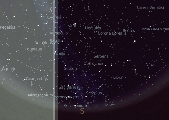 | 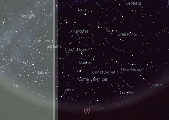 | 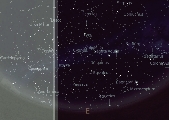 | 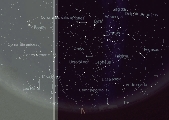 | click, from right to left, to the Summer Triangle with the southern horizon, the western horizon, the eastern horizon, and the northern horizon. retrieve the printer-friendly equivalents of those charts: (Summer Triangle with the southern horizon, western horizon, eastern horizon, northern horizon) |
Check these pages for charts for June and September, as the texts are those published on the site 'Amateur Astronomy' only, leaving the user to extrapolate by himself from the more detailed guide given for July and August, like above. The main trick is that in June, the sky is shifting eastwards, with, for example, the Summer Triangle still low East, as some more constellations below Arcturus, for example are seen West. And, in September, the sky has shifted westwards, meaning that Arcturus is now much low, West as, East more plain views of the Great Square of Pegasus are easier. In any case, first read the tutorial above, 'Touring the Summer Night Skies, a Guide', which thus gives you the basics of the summer skies. In June you'll see those slightly ahead of schedule, and in September slightly after schedule
|
|
|
(color maps with Stellarium; printer-friendly charts with Cartes du Ciel, Patrick Chevalley)
Those two hemispherical maps are a further bonus with the pack. Such hemispherical sky charts are much usual tools with amateur astronomers. With a limiting magnitude of the 6th magnitude, they provide a comprehensive view of both the northern and southern parts of the celestial sphere, allowing for some swift check of a position or the general approach of the whole celestial sphere
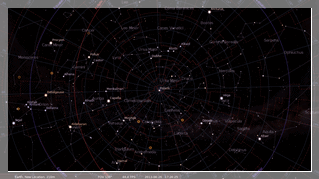 | 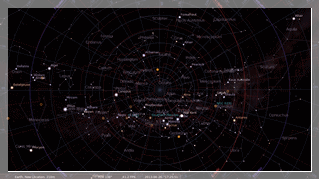 | click on the chart (left) to a northern hemispherical sky chart or the chart (right) to a southern hemispherical sky chart |
->Feeling interested by the hobby? See more subjects, and detailed studies, at the site 'Amateur Astronomy'!
Website Manager: G. Guichard, site 'Amateur Astronomy,' http://stars5.6te.net. Page Editor: G. Guichard. last edited: 12/28/2010. contact us at ggwebsites@outlook.com